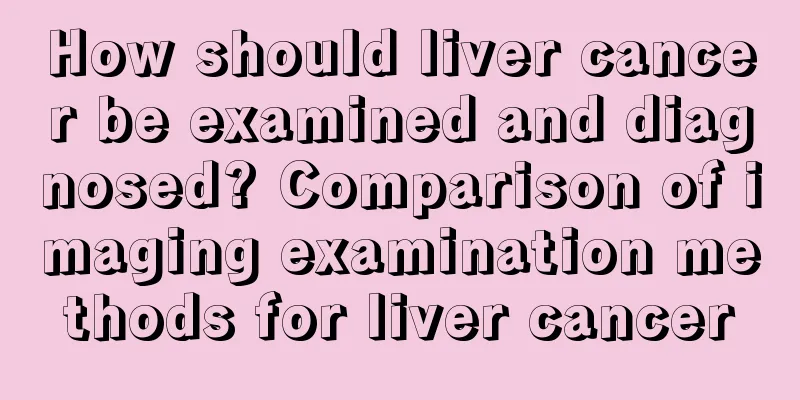How should liver cancer be examined and diagnosed? Comparison of imaging examination methods for liver cancer

|
CT and magnetic resonance imaging (MRI) are imaging examination methods commonly used in the diagnosis and treatment of liver cancer. What are the differences between these two examinations? How should patients choose? Let's compare the differences between CT examination and MRI examination of liver cancer. CT examination of liver cancer The emergence of CT has made a qualitative leap in the imaging diagnosis of liver cancer and promoted the progress of liver surgery. The resolution of CT is much higher than that of ultrasound, and the image is clearer and more stable, which can more comprehensively and objectively reflect the characteristics of liver cancer. CT examination can clearly show the size, number, shape, location, boundary, tumor blood supply, and relationship with intrahepatic ducts of liver cancer; it has important diagnostic value for whether there are cancer thrombi in the portal vein, hepatic vein and inferior vena cava, whether there is metastasis in the portal and abdominal lymph nodes, and whether liver cancer invades adjacent tissues and organs; CT can also judge the severity of liver cirrhosis by showing the shape of the liver, the size of the spleen, and the presence or absence of ascites. Fast spiral CT can scan the entire liver in one breath-hold (about 20 seconds), which can avoid missing tiny lesions due to up and down movement of the plane caused by respiratory movement, and can also overcome the problem of artifacts caused by respiratory movement. Spiral CT can perform thin-layer scanning with a minimum layer thickness of 1 mm, and the detection rate of small liver cancers of 1 to 3 cm can reach 90%, and high-quality three-dimensional image reconstruction can be performed within the length of the spiral scan. For liver cancer that is difficult to make a clear diagnosis with enhanced CT, angiographic CT can be further used. Contrast agent is injected into the hepatic artery through a percutaneous catheter, and CT is observed when the hepatic artery is developed, which is called CT angiography. MRI of liver cancer does not cause radioactive radiation and can be imaged from multiple directions. The new MRI has overcome the disadvantage of the early imaging speed being too slow. The field strength has been increased to 1.5-2.0T, making a variety of new imaging technologies such as gradient echo sequence and spectral analysis possible. In addition, the use of hepatocyte-specific contrast agents has greatly improved the detection rate of small liver cancers. The detection rate of lesions smaller than 1 cm is 55%, 1-2 cm is 70%, and 2-3 cm is 82%. MRI can clearly display the intrahepatic blood vessels and bile duct structure, which is very helpful in understanding the relationship between tumors and intrahepatic blood vessels and bile ducts. MRI can also better display the internal structure of the liver and liver cancer tissues, which is very helpful in evaluating the efficacy of various treatments. For example, after percutaneous intratumoral alcohol injection, radiofrequency ablation or microwave curing, tumor necrosis appears as a uniform low signal in the T2 stage. If the signal inside the tumor is uneven, it often indicates incomplete necrosis after treatment. MRI is easy to detect small liver cancers located on the surface of the liver that are difficult to detect with CT, and is also highly sensitive to small metastatic lesions in the liver. However, the edge of the left lobe of the liver is affected by the pulsation of the heart and aorta, and the detection rate of small liver cancer is not much different from that of CT. Other imaging methods for liver cancer ① Ultrasound examination can show the size, shape, location of the tumor and the presence of tumor thrombus in the hepatic vein or portal vein, with a diagnostic accuracy rate of up to 90%. ② Selective celiac artery or hepatic artery angiography can detect vascular-rich tumors with a resolution of about 1 cm. |
<<: Can advanced lung cancer be cured? What are the treatments for advanced lung cancer?
Recommend
What are the signs of colorectal cancer recurrence
What are the signs of colorectal cancer recurrenc...
Contraindications for radiotherapy of cervical cancer
Radiation therapy is a commonly used treatment fo...
How to use a juicer
Juicer is a machine used in our daily life to qui...
Lip whitening, symptomatic treatment works quickly
As time goes by, more and more female friends hav...
Treatment of endometrial cancer with traditional Chinese medicine based on syndrome differentiation
Traditional Chinese medicine divides endometrial ...
Is it coronary heart disease or pituitary tumor?
79-year-old Grandpa Ma developed loss of appetite...
Manifestations of a dark psychology
A dark psychology is also a relatively common psy...
Effects of pyramidal tract damage
When the pyramidal tract is damaged, the brain lo...
What to do with a dry nose? 7 tips for taking care of it
In the dry environment of winter, or in condition...
Can I eat sweet beans if I have constipation?
Many of our friends may have eaten sweet beans in...
I was very swollen the next day after taking the hyaluronic acid injection
Hyaluronic acid is a relatively common beauty met...
How to treat patients with laryngeal cancer and pulmonary tuberculosis
Xu Wei's mother is nearly 70 years old this y...
What is the reason for feeling dizzy in the head
Some people are full of energy and positive every...
What harm can small cell lung cancer cause
What harm can small cell lung cancer cause? Many ...
How to treat ganglion cyst to eradicate it
Ganglion cysts are quite common in daily life. Th...









